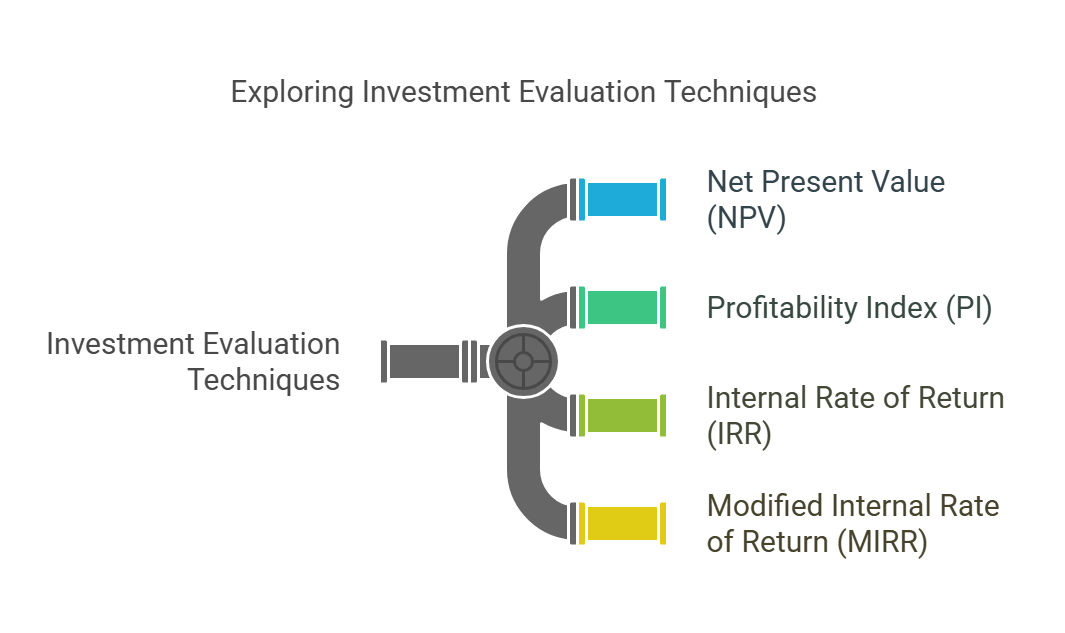Investment Evaluation Techniques
Discounting Methods
Discounting methods consider the time value of money, which recognizes that a dollar received today is worth more than a dollar received in the future. These methods are more sophisticated and provide a more accurate assessment of project profitability.

-
Net Present Value (NPV):
-
Definition: The net present value is the sum of the present values of all cash flows (both inflows and outflows) associated with a project, discounted at a specified discount rate (cost of capital).
-
Calculation:
- NPV = Σ [CFt / (1 + r)^t] - Initial Investment
- Where:
- CFt = Cash flow in period t
- r = Discount rate (cost of capital)
- t = Time period
- Σ = Summation over all time periods
- Where:
- NPV = Σ [CFt / (1 + r)^t] - Initial Investment
-
Decision Rule:
- NPV > 0: Accept the project (it is expected to increase shareholder wealth).
- NPV < 0: Reject the project (it is expected to decrease shareholder wealth).
- NPV = 0: The project is expected to neither increase nor decrease shareholder wealth.
-
Advantages:
- Considers the time value of money.
- Considers all cash flows over the project's life.
- Provides a direct measure of the project's value creation.
-
Disadvantages:
- Requires an estimate of the discount rate, which can be subjective.
- Can be difficult to compare projects of different sizes (requires further analysis like Profitability Index).
-
-
Profitability Index (PI):
-
Definition: The profitability index, also known as the benefit-cost ratio, is the ratio of the present value of future cash flows to the initial investment.
-
Calculation:
- PI = (Present Value of Future Cash Flows) / Initial Investment
- PI = (NPV + Initial Investment) / Initial Investment
-
Decision Rule:
- PI > 1: Accept the project.
- PI < 1: Reject the project.
- PI = 1: The project is expected to break even.
-
Advantages:
- Considers the time value of money.
- Considers all cash flows over the project's life.
- Provides a relative measure of profitability, useful for comparing projects of different sizes when capital is constrained.
-
Disadvantages:
- Requires an estimate of the discount rate.
- May lead to incorrect decisions when projects are mutually exclusive and have different initial investments.
-
-
Internal Rate of Return (IRR):
-
Definition: The internal rate of return is the discount rate that makes the net present value of a project equal to zero. It represents the rate of return that the project is expected to earn.
-
Calculation:
- The IRR is the value of 'r' that satisfies the equation: 0 = Σ [CFt / (1 + r)^t] - Initial Investment
- The IRR is usually found using iterative methods or financial calculators/software.
-
Decision Rule:
- IRR > Cost of Capital: Accept the project.
- IRR < Cost of Capital: Reject the project.
- IRR = Cost of Capital: The project is expected to break even.
-
Advantages:
- Considers the time value of money.
- Considers all cash flows over the project's life.
- Provides a rate of return that is easy to understand and compare to other investments.
-
Disadvantages:
- Can be difficult to calculate manually.
- May not exist or may have multiple solutions for non-conventional cash flows (e.g., cash flows that change sign more than once).
- May lead to incorrect decisions when projects are mutually exclusive and have different scales or timing of cash flows.
-
-
Modified Internal Rate of Return (MIRR):
-
Definition: The modified internal rate of return is a variation of the IRR that addresses some of the shortcomings of the traditional IRR. It assumes that positive cash flows are reinvested at the cost of capital and that negative cash flows are financed at the financing rate.
-
Calculation:
-
- Calculate the Terminal Value (TV) of all positive cash flows, compounded at the cost of capital (reinvestment rate) to the end of the project's life.
-
- Calculate the Present Value (PV) of all negative cash flows, discounted at the financing rate back to the beginning of the project's life.
-
- MIRR = (TV / PV of outflows)^(1/n) - 1
- Where 'n' is the number of years.
-
-
Decision Rule:
- MIRR > Cost of Capital: Accept the project.
- MIRR < Cost of Capital: Reject the project.
-
Advantages:
- Considers the time value of money.
- Avoids the multiple IRR problem associated with non-conventional cash flows.
- Provides a more realistic measure of the project's rate of return by explicitly accounting for the reinvestment rate.
-
Disadvantages:
- More complex to calculate than the traditional IRR.
- Requires estimates of both the cost of capital (reinvestment rate) and the financing rate.
-
In summary, discounting methods provide a more sophisticated and accurate assessment of project profitability than non-discounting methods by considering the time value of money. The NPV, PI, IRR, and MIRR are all valuable tools for investment decision-making. The choice of which method to use depends on the specific circumstances of the project and the preferences of the decision-makers.

No Comments